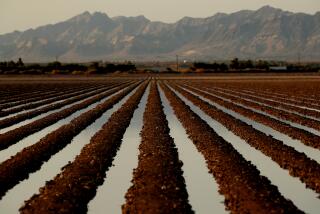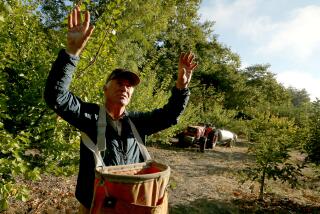Drought Cripples Arizona Farmers
- Share via
PHOENIX — A nearly decade-long drought is changing the way Frank Martin does business at his Crooked Sky Farms in Glendale.
Martin still grows lettuce, beets, bok choi, cabbage and cauliflower on his 26-acre farm.
But growing water-intensive crops -- such as sweet corn -- is a thing of the past, as is farming much in the summer or watering when rain is imminent.
The Western drought is making farmers think twice about their practices.
They are avoiding water-intensive crops, scaling back their plots, watering only at dusk and dawn, implementing conservation measures and installing water-saving devices.
“We really play the hand that we are dealt,” said Will Rosseau, a fourth-generation farmer. “We are always trying to shave production costs, make ourselves more efficient in terms of water.”
The drought has been wreaking havoc on Western states from the border with Mexico to Canada for nearly a decade, but with Arizona facing its worst drought in recorded history, the last two years have been especially difficult for farmers here.
For the second year in a row, farmers who receive water from the Salt River Project, which delivers surface water from the Salt and Verde rivers, have had their allocations cut by one-third.
“Now all of the sudden everybody is worried,” said Martin, 48.
SRP, one of the Phoenix area’s largest water suppliers, cut deliveries to all of its customers in January 2003 after levels in reservoirs fell, said SRP hydrologist Bruce Halon.
The utility’s municipal customers absorbed the cutback by increasing their use of water from wells and a canal system that delivers Colorado River water to central Arizona.
But many farmers couldn’t do that.
“It is pretty unfair that farmers have cut back 30% of water and have done conservation efforts when people in the cities have hardly cut back water use by 5%,” said Gary Nabhan, of the Center for Sustainable Environments at Northern Arizona University.
Irrigation use fell nationwide from 150 billion gallons daily to 137 billion gallons daily from 1980 to 2000, according to the U.S. Geological Survey.
During that same period, water use from public water systems nationwide increased, because of population growth, from 34 billion gallons to 43 billion gallons a day.
Even though irrigation use has been declining and public water use has been increasing, irrigation still sucks up seven times more water than public supply in the West, said Susan Hutson, a hydrologist with the U.S. Geological Survey.
It’s still not enough, according to many farmers.
Nabhan said the cutbacks were increasing production costs, diminishing yields and increasing debt for the farmers.
“Water is your lifeline in the agriculture business,” said Glendale farmer Bill Tolmachoff.
Some growers have found ways to cope.
Nabhan grows desert-adapted crops, such as tepary beans, sunflowers and blue corn.
Others are just quitting.
“They are just throwing in the towel and selling out to developers,” Nabhan said.
An average of 100 farms in Arizona have been going under every year since the drought began, Nabhan said.
Competition from overseas isn’t helping.
The water restrictions have increased the farmers’ production costs by forcing them to get water from more expensive sources, which consumers see on the price tags for farm goods. Consequently more produce is being purchased from other countries, Nabhan said.
“Everybody is really just holding their breath,” said Dee Logan, an Arizona Community Farmers’ Markets coordinator.
The same thing is evident across the region. In parts of Idaho, the only farmers who were expected to get water this summer may be those with water rights from the 1800s. In New Mexico, farmers are expected to face dramatic reductions.
The U.S. Natural Resources Conservation Service is forecasting the potential for water restrictions and widespread crop and pasture losses in parts of Utah, Nevada, Idaho and Montana.
When the drought ends things may take years to return to normal, if they ever do.
The food-producing capacity does not immediately rebound once rainfall returns to normal, Nabhan said. Instead, productivity is damaged to the point that pre-drought rates may never be achieved again.
“This is a long-term threat to our food security that may last 50 years or more,” Nabhan said.
As for Martin, he said water will continue to occupy his every thought as the drought continues to ravage his land.
“There is no real sign that this is letting up,” he said. “It doesn’t look good.”
More to Read
Sign up for Essential California
The most important California stories and recommendations in your inbox every morning.
You may occasionally receive promotional content from the Los Angeles Times.










